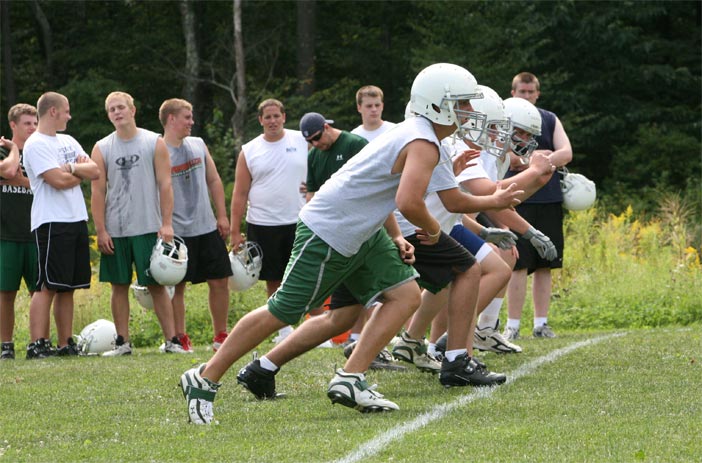
I want to discuss in-season football training and what has worked for my athletes. I’ve coached high school football for six years and have seen one critical factor that has caused our football players to lose strength and size.
Currently, I have three football players who are training in-season and have maintained strength and size through the middle of the season. These football players train once or twice a week and their workouts last 30–40 minutes. There is a very “critical window” in which your players will be able to maintain the muscle mass and desired body weight. Here’s what I’ve seen with football players over the past six years.
High school students usually eat lunch around 11:30 a.m. –12:00 p.m. School ends at around 2:30 p.m. and football starts shortly after. By the time the football players get out of practice and home, it might be 6:30–7:00 p.m. That’s a long time to go without food—from when they eat lunch until when they get home for dinner. Between the end of school and practice, your athletes need to find a way to get in a meal. This “critical window” can and will help the athletes maintain their desired playing weight and help them keep muscle mass on throughout the season. This is where your athletes have to do the “little things” that will help them during the remainder of the season. I’m currently training a lineman who, at the start of the season, was 270 lbs.
Before and after shots of Jesse:
December 2009, 230 lbs
July 2010, 270 lbs
We’re going into week five and Jesse is still hovering at around 265–270 lbs. He has maintained his strength and muscle mass. Here’s what he does to help stay on top of his game. I’ll give you examples of his after-school meals as well as his in-season workouts. You’ll find it to be quite simple for your athletes to do. If they aren’t doing this after school, they’re just making excuses. Check them out.
Before practice meals:
1. Two peanut butter and jelly on 100 percent whole wheat bread, one banana, and a carton of milk
2. Two turkey sandwiches on 100 percent whole wheat bread, a scoop of peanut butter with an apple
3. Big 100 Colossal protein bar, cookies and cream flavor (high in calories and protein)
4. I told you it was simple, so simple most athletes won’t do it.
In-season workouts:
1a. Box squat, 6 X 3 (50%), 30 seconds rest between sets
1b. Stretch hip flexor, 10 seconds
2. Dumbbell push-ups with 20-lb chains, 3 X 8–15
3. Inverted rows with close grip fat bar, 3 X 8–15
4. Barbell curls, 2 X 8–12
5. Prowler sprints, 4–6 sprints (30 seconds rest)
6. Planks, side planks, bridges, 3 X 30 seconds each
1a. Football bar bench press, 5 X 4 (50%) 30 seconds rest between sets
1b. Band scarecrows, 5 X 10
2a. Kettlebell clean and press, 3 X 5
2b. Wide grip pull-up, 3 X 5 (20-lb vest)
3. Up-right walking sled drags, 3–4 trips
4. Grip work and abs
Our in-season athletes have to be held accountable, and as strength coaches, we need to keep them educated and informed during the season. It’s important that the athletes are still eating breakfast and taking small meals to school. Without the after-school meal, our athletes will be losing strength, energy, and muscle mass. Get your athletes to maintain good habits and communicate with them. Show them that you care about their playing performance and keep them healthy.











